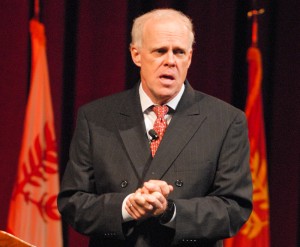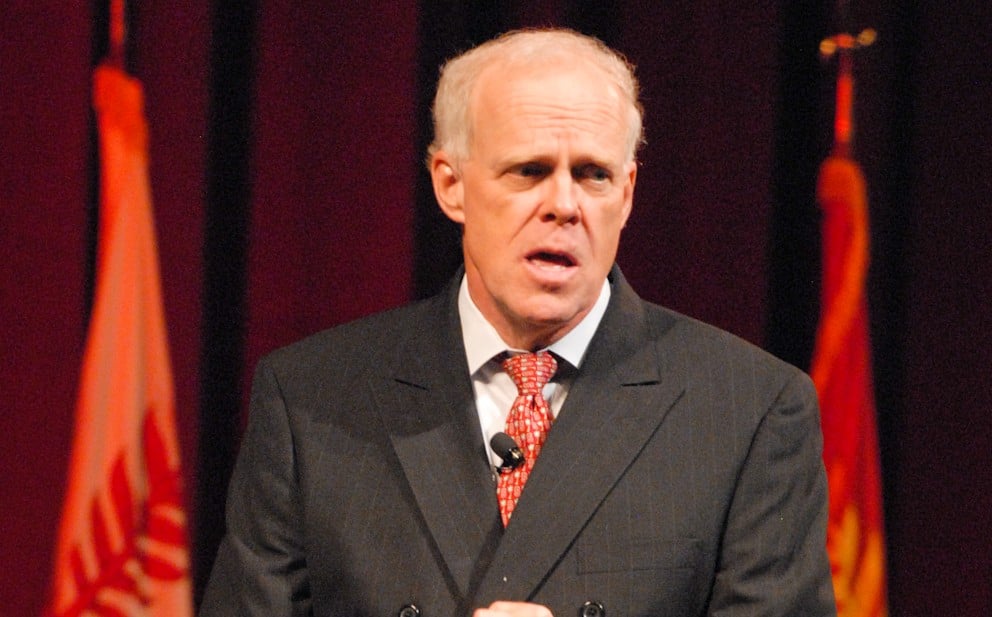Stanford University President John Hennessy sat down with The Stanford Daily on Oct. 29 to discuss a wide range of topics, including online education, Stanford’s failed campaign for a New York City campus last fall, Stanford’s fundraising prowess and more.

This is the second of four installments of that interview; this one focuses on Stanford’s failed attempt in 2011 to win New York City’s competition for an applied sciences and engineering campus. Cornell University won the competition and will build a campus on Roosevelt Island.
TSD: Sort of tangentially related to [online education] is the New York City campus. When you talk about satellite campuses, is that something that the school is very focused on?
JH: We’re not right now. The New York City situation was rather unique in the sense that it was a location in the world where we could imagine recruiting faculty and where we would imagine students would want to go. It’s harder to find other places where it’s just as easy to recruit faculty.
There are lots of people who would like us to set up things, but the key thing is … if you can’t recruit faculty, and the very best faculty, then you’re going to have something which is not of a Stanford caliber and I think there’s no interest in doing that, in taking the University’s brand and, in some sense, diluting it by having something that’s less, lower quality.
TSD: So if Stanford were to do a second campus in the future, do you think New York would still be the first choice?
JH: I think it might well be … we’ll see what happens in the city’s trajectory in the next few years ahead as the person who’s been mayor for 12 years will be stepping down and that … will certainly be a change in the city. How big of a change? That’s unclear, I think. So New York comes with the advantage of being a magnet for highly talented people and intellectuals. It comes with the disadvantages that it’s a very hard place to do business. Very expensive. I found a place that’s more expensive than building on our campus, and that’s New York City … that’s its downside and that has to balance against the [positives].
My guess is for the next few years, we’ll be asking questions about how we use online, because I think we’re already in the best place in the world we could possibly be. It’s right here. So, a question is, “Can we use online to amplify what we can do on campus? And are there ways to do it that would still provide students with an opportunity to be on our campus but maybe use online to magnify that effect somehow?” We’ll see.
TSD: Looking back on this process, a year removed, and looking back a little more deeply on New York, are there any regrets you have on the Stanford end of things or on the way New York or Cornell handled things?
JH: You know, perhaps we could have figured out or detected some things earlier than we did — that we didn’t figure out or detect until we got into final negotiations. But I’m not sure because it’s very hard to separate out the dynamics of what was going on from the details of where we found ourselves in negotiating a deal. I mean, perhaps we could have figured it out sooner. But I’m not sure of that. It was a very hard thing to ascertain.
Other than that, I think the other thing, probably, is the cost hurdles for the project grew significantly from the first impressions of them. And, again, this project ran on at race neck speed for a University project. It was running much faster than anything we’ve ever done before. So in some sense, I don’t know how we could have figured out, for example, that the cost to activate Roosevelt Island and bring it to the place where you had done the infrastructure and you were ready to build the first building was three times higher than we initially estimated. I don’t know how you could have figured that out faster, but it certainly would have been nice if we could have figured that out faster. Because that would have said the hurdle was higher and maybe we would have then said, “The hurdle’s higher, we need to have a different set of terms under which we’re negotiating this deal given that.” What that would have done, if anything, was it would have probably raised some objections earlier before we got into the final negotiation process and maybe we could have cut bait sooner. I’m not sure, but it’s worth asking.
I don’t think there’s anything else that I wanted there. I thought we should win the process on the basis of the merits of our proposal and our willingness to invest in it. I didn’t think conducting a political campaign was the right thing. And I don’t think, in the end, it was the big issue anyway. But, anyway, it’s an interesting process to go through.
TSD: It seemed at least, from an outsider’s perspective, like the University had a lot of momentum going and had done a ton of work on this proposal and then very abruptly withdrew. Was there one term that came up that caused that or was it just sort of eventually, you met with other people and decided?
JH: Well, the straw that broke the camel’s back I suppose, in the end, it was just there were too many conditions imposed on the project and I think it just got to the point where the University was being asked to carry the lion’s share of risk. The city was dumping risk on the University and wasn’t giving us anything in return. It’s not like they were saying, “Okay, we’re going to give you more land or we’re going to give you more money. No, you take all the risk and if it fails, even if it’s our fault, you pay us.” I mean … that was just crazy.
So … I had told the Board if we didn’t get a deal we liked, I was going to pull the plug. So, the team was back there negotiating, I was getting daily reports on that and I just said, “This is going the wrong way.” And we realized that, that was the team we were going to have to work with for the next decade-plus if we went ahead with the project. I just said, “This is not a partnership between a nonprofit that’s investing far more than the city, I mean five to 10 times over 20, 30 years what the city was going to invest.” So, I just said — and I told the Trustees — if it wasn’t a good deal, I’ll pull the plug. And they were nervous I wasn’t going to pull the plug, but I did.
Tomorrow’s installment will focus on Stanford’s fundraising success and uses of that money.
